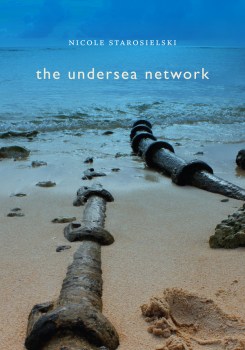The Undersea Network That Connects the World
An excerpt from “The Undersea Network.”
The following is excerpted from The Undersea Network, by Nicole Starosielski.
Undersea fiber-optic cables are critical infrastructures that support our global network society. They transport 99 percent of all transoceanic digital communications, including phone calls, text and e-mail messages, websites, digital images and video, and even some television (cumulatively, over thirty trillion bits per second as of 2010). It is submarine systems, rather than satellites, that carry most of the Internet across the oceans. Cables drive international business: they facilitate the expansion of multinational corporations, enable the outsourcing of operations, and transmit the high-speed financial transactions that connect the world’s economies. Stephen Malphrus, staff director at the U.S. Federal Reserve Board, has stated that if the cable networks are disrupted, “the financial services sector does not ‘grind to a halt,’ rather it snaps to a halt.”
As a result, the reliability of undersea cables has been deemed “absolutely essential” for the functioning of governments and the enforcement of national security. Militaries use the cables to manage long-range weapons tests and remote battlefield operations. Undersea networks also make possible new distributions of transnational media that depend on high-capacity digital exchange, from the collaborations of production companies in the United States and New Zealand on the 2009 film Avatar to the global coordination of World of Warcraft players. At the same time, cable infrastructure enables modes of resistance that challenge dominant media formations. Messages produced by the Arab Spring and Occupy movements traveled between countries on undersea cables. If the world’s 223 international undersea cable systems were to suddenly disappear, only a minuscule amount of this traffic would be backed up by satellite, and the Internet would effectively be split between continents.
***
Packet-switching technology, which forms the basis for the Internet’s distributive operations, is often understood in terms of its potential to survive an attack: if several nodes in a network are disrupted, the system’s routing can in theory move traffic around them. The relative centralization of the cable system and its embeddedness in existing territorialities make the physical networks across which these packets move far less resilient than we imagine. In 2006 an earthquake near Taiwan set off an undersea landslide and snapped several cables. Another significant outage happened in Vietnam in 2007, when cable thieves pulled up several of the country’s working lines. In 2011 a woman in Georgia shut down much of the Internet in Armenia when she dug up two fiber-optic lines while looking for scrap metal. Although network carriers are often able to reroute traffic, in many cases, breaks have decreased Internet connectivity. Repairing undersea networks is dependent on a limited number of specialized cable ships, and in some places, including China, Italy, and Indonesia, companies have had to wait to receive permits before they can fix their systems.

***
Although the Internet is often imagined as a clean and durable technology, something that will eventually be extended everywhere at little cost, this vision fails to register the extensive financial, social, and environmental investments required to establish new systems and maintain existing ones. Taking this into consideration, we might think about the Internet not as a renewable resource but as a precarious platform, especially as moving our data to the cloud often entails increased dependence on undersea links. On one hand, this might help us make better choices about our own media consumption and content production, taking into account the potential precariousness of infrastructural systems. On the other hand, it might motivate us to push for a more genuinely distributed, resilient, and equitable network.
Excerpted from The Undersea Network by Nicole Starosielski. Copyright Duke University Press 2015
Nicole Starosielski is assistant professor of media, culture, and communication at New York University.